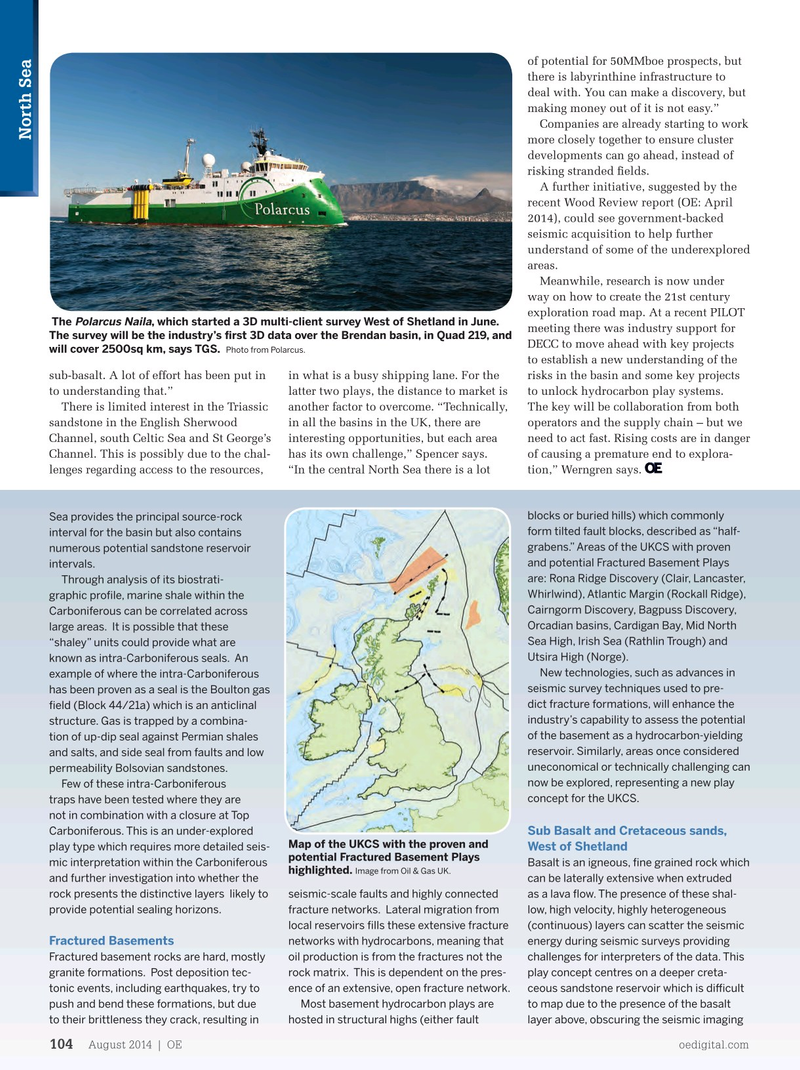
Page 102: of Offshore Engineer Magazine (Aug/Sep 2014)
Read this page in Pdf, Flash or Html5 edition of Aug/Sep 2014 Offshore Engineer Magazine
of potential for 50MMboe prospects, but there is labyrinthine infrastructure to deal with. You can make a discovery, but making money out of it is not easy.”
Companies are already starting to work
North Sea more closely together to ensure cluster developments can go ahead, instead of risking stranded ? elds.
A further initiative, suggested by the recent Wood Review report (OE: April 2014), could see government-backed seismic acquisition to help further understand of some of the underexplored areas.
Meanwhile, research is now under way on how to create the 21st century exploration road map. At a recent PILOT The , which started a 3D multi-client survey West of Shetland in June.
Polarcus Naila meeting there was industry support for
The survey will be the industry’s ? rst 3D data over the Brendan basin, in Quad 219, and
DECC to move ahead with key projects will cover 2500sq km, says TGS. Photo from Polarcus. to establish a new understanding of the sub-basalt. A lot of effort has been put in in what is a busy shipping lane. For the risks in the basin and some key projects to understanding that.” latter two plays, the distance to market is to unlock hydrocarbon play systems.
There is limited interest in the Triassic another factor to overcome. “Technically, The key will be collaboration from both sandstone in the English Sherwood in all the basins in the UK, there are operators and the supply chain – but we
Channel, south Celtic Sea and St George’s interesting opportunities, but each area need to act fast. Rising costs are in danger
Channel. This is possibly due to the chal- has its own challenge,” Spencer says. of causing a premature end to explora- lenges regarding access to the resources, “In the central North Sea there is a lot tion,” Werngren says. blocks or buried hills) which commonly
Sea provides the principal source-rock form tilted fault blocks, described as “half- interval for the basin but also contains grabens.” Areas of the UKCS with proven numerous potential sandstone reservoir and potential Fractured Basement Plays intervals.
are: Rona Ridge Discovery (Clair, Lancaster,
Through analysis of its biostrati-
Whirlwind), Atlantic Margin (Rockall Ridge), graphic pro? le, marine shale within the
Cairngorm Discovery, Bagpuss Discovery,
Carboniferous can be correlated across
Orcadian basins, Cardigan Bay, Mid North large areas. It is possible that these
Sea High, Irish Sea (Rathlin Trough) and “shaley” units could provide what are
Utsira High (Norge).
known as intra-Carboniferous seals. An
New technologies, such as advances in example of where the intra-Carboniferous seismic survey techniques used to pre- has been proven as a seal is the Boulton gas dict fracture formations, will enhance the ? eld (Block 44/21a) which is an anticlinal industry’s capability to assess the potential structure. Gas is trapped by a combina- of the basement as a hydrocarbon-yielding tion of up-dip seal against Permian shales reservoir. Similarly, areas once considered and salts, and side seal from faults and low uneconomical or technically challenging can permeability Bolsovian sandstones. now be explored, representing a new play
Few of these intra-Carboniferous concept for the UKCS.
traps have been tested where they are not in combination with a closure at Top
Carboniferous. This is an under-explored
Sub Basalt and Cretaceous sands,
Map of the UKCS with the proven and play type which requires more detailed seis-
West of Shetland potential Fractured Basement Plays mic interpretation within the Carboniferous Basalt is an igneous, ? ne grained rock which highlighted.
Image from Oil & Gas UK.
and further investigation into whether the can be laterally extensive when extruded rock presents the distinctive layers likely to seismic-scale faults and highly connected as a lava ? ow. The presence of these shal- provide potential sealing horizons. fracture networks. Lateral migration from low, high velocity, highly heterogeneous local reservoirs ? lls these extensive fracture (continuous) layers can scatter the seismic networks with hydrocarbons, meaning that energy during seismic surveys providing
Fractured Basements
Fractured basement rocks are hard, mostly oil production is from the fractures not the challenges for interpreters of the data. This granite formations. Post deposition tec- rock matrix. This is dependent on the pres- play concept centres on a deeper creta- tonic events, including earthquakes, try to ence of an extensive, open fracture network. ceous sandstone reservoir which is di

 101
101

 103
103